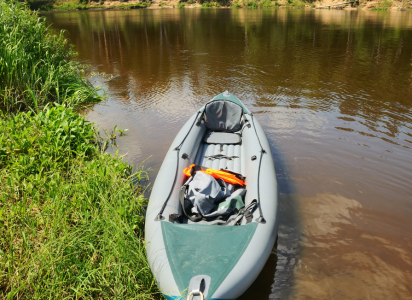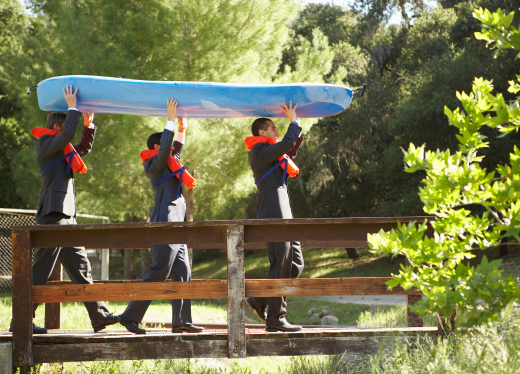If you’re new to the world of inflatable kayaks, it can be a little daunting figuring out how to get in.
With their buoyancy and flexibility, it can seem like you’ll never be able to get in without tipping over. The first few times I tried it with my Sea Eagle, it felt really tricky but fear not! By following these tips and tricks, you’ll be gliding along like a pro in no time.
Getting into an Inflatable Kayak
There are several ways to get into an inflatable kayak so go through each one of these, print them, and try them each a couple of times.
#1. The Island Method

When you’re ready to get in the kayak on the water, start by pulling up to a shallow area or island. Take your paddle and stick it perpendicular to the kayak, with the paddle blade resting on the shore or island.
Then use the paddle as a stabilizer to help you climb into the kayak. Place one hand on the paddle, and one hand on the kayak, and lift yourself in.
#2. The Butt Scoot
If you’re having trouble getting your legs in, try the butt scoot method. Sit down on the edge of the kayak and swing your legs inside. Then, use your hands to scoot your butt further into the kayak until you’re comfortable.
Once you’re in, reach forward and grab onto the paddle to stabilize yourself.
#3. The Swim Method
If you happen to fall out of the kayak while you’re on the water, don’t panic. The swim method is an easy way to get back in.
Start by swimming to the back of the kayak and grab onto the side.
Then, use your legs to push yourself up and onto the back of the kayak. Once you’re stabilized, swing your legs inside and sit down.
#4. Remember: Practice Makes Perfect

Before you even get to the water, take a few minutes to practice getting in and out of your kayak on land. This will help build your confidence and allow you to figure out the best way to enter the kayak.
Sit down on the ground next to your kayak, with your legs inside. Use your hands to grab onto the sides of the kayak and wiggle your way in.
Practice different angles and methods to figure out what works best for you.
#5. Be Confident and Have Fun
The most important thing when getting in an inflatable kayak is to be confident and have fun!
Don’t worry if you get a little wet or wobbly at first – everyone starts there. Inflatable kayaks are more buoyant so require more patience.
With practice and patience, you’ll soon be gliding along the water like a pro.
How Do I Get into My Inflatable Kayak from a Dock?
If you’re a beginner, I don’t advise you to get into your inflatable kayak from a dock. However, if you insist on learning, take each step slowly and keep your balance the best you can.
Getting into your inflatable kayak from a dock requires a slightly different approach. Start by placing your kayak parallel to the dock, ensuring that the dock is low enough for easy access into your kayak.
If it’s too high, you might want to look for a different launch point. Once your kayak is in position, sit down on the edge of the dock with your legs over the side and directly above the kayak.
Slowly lower yourself down into the kayak, maintaining a hold on the dock for stability. Swing your legs into the kayak one at a time, keeping your weight centered to prevent tipping. Once you’re seated comfortably, grab your paddle and push off from the dock.
How Do I Get into My Inflatable Kayak from the Beach?
Entering your inflatable kayak from a beach is fairly straightforward and super duper easy!
Begin by positioning your kayak perpendicular to the water’s edge, with the back end facing the water.
Ensure the kayak is stable, perhaps by weighting it down with your gear. Sit down at the back end of your kayak, with your legs pointing towards the bow (front).
Gradually slide yourself into the cockpit, bringing your legs inside. To avoid friction against the bottom, make sure the water is deep enough to float the kayak slightly. Finally, grab your paddle and start kayaking.
Always remember to maintain balance and move slowly to avoid tipping over.
Is It Hard to Get in and out of an inflatable kayak vs a hardshell kayak?

Both inflatable and hardshell kayaks present their unique challenges when it comes to getting in and out.
However, due to their buoyancy and flexibility, inflatable kayaks can feel a bit unstable, especially for beginners. Their bottoms are softer, which means they can shift more under your weight as you’re trying to get in or out, potentially causing imbalance.
On the other hand, hardshell kayaks are more rigid and sturdy, providing a stable platform for entry and exit. However, they can be more challenging to climb into from water if you happen to capsize, due to their higher sides and weight.
What is the easiest spot a beginner should launch their inflatable kayak from?
For beginners, the easiest spot to launch an inflatable kayak is a sandy beach with a gentle slope and calm waters. This type of location allows for a smooth, controlled entry into the kayak, reducing the risk of tipping over.
Additionally, the soft sand can serve as a cushion in case of a fall. The gentle slope will let you gradually glide into the water once you’re seated in the kayak, while the calm waters will make your first few moments of paddling less daunting.
It’s also beneficial if the area has a shallow water depth for some distance from the shore, providing a safety net while you’re still getting the hang of balancing and maneuvering the kayak.
In Summary
Getting in an inflatable kayak may seem overwhelming at first, but with a little bit of practice and these tips and tricks, you’ll be a pro in no time.
Remember to start slowly, build your confidence, and have fun. Before you know it, you’ll be exploring new waterways and enjoying all the benefits of this versatile and exciting type of watercraft.
Being patient will go a long way here; trust me, this is coming from someone who wants to learn at the snap of a finger! If you want to learn how to get back in your kayak after you’ve fallen out, you might be interested in reading that article.
